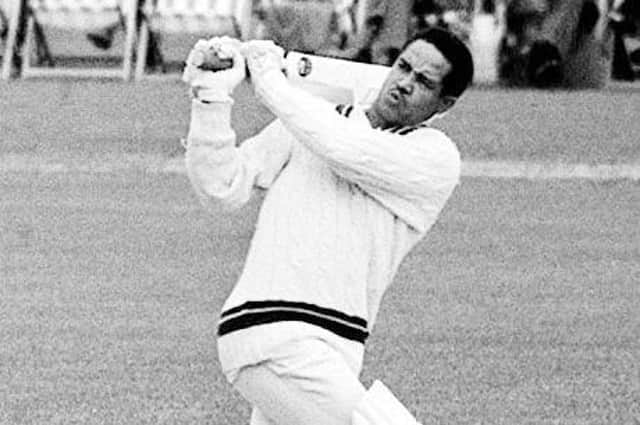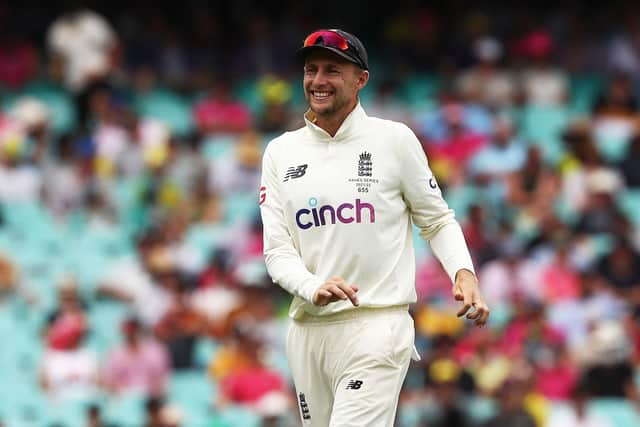Sporting bygones: Cricket’s new ‘tee-total’ attitude will amuse players like legendary West Indies party animal Garry Sobers


ONE thought crossed my mind as I listened to the preposterous hoo-hah that attended the news that England players were part of an all-night drinking session after the final Ashes Test in Hobart.
That thought was this: I wonder what Garry Sobers would have made of it all?
Advertisement
Hide AdAdvertisement
Hide AdSobers, the great West Indian all-rounder, for many the greatest all-rounder that the game has seen, would no doubt have burst out laughing somewhere in Barbados.


Good grief, a handful of players – actually England’s Joe Root and James Anderson, plus Australia’s Nathan Lyon, Alex Carey and Travis Head – having the temerity to enjoy a few late-night/early-morning beers at the end of a Test series?
Why, I could almost hear Sobers – party animal and cricketer extraordinaire – chuckling from ear to ear.
Leaving aside the bizarre antics of Graham Thorpe, the England assistant coach who filmed police breaking up the drinking session after officers were initially called because Thorpe had been smoking a cigar inside the team hotel (an illegal act in Tasmania), the high-jinks were surely blown out of all proportion.
Advertisement
Hide AdAdvertisement
Hide AdIndeed, those players drinking on the outdoor terrace at the rear of the hotel at 6am (the match itself had finished very late as it was a day/night fixture), left without fuss and went off to bed.


It was only the fact that Thorpe’s mobile phone footage somehow found its way on to the Sydney Morning Herald website that seemed to irritate the England and Wales Cricket Board, which immediately launched an investigation (it has launched so many investigations lately that it will surely end up in The Guinness Book of Records).
Of course, had there been reports of televisions being thrown out of hotel windows, hotel rooms being trashed, processions of nubile young women coming and going from players’ bedrooms, vapour clouds of cannabis smoke lingering in hotel corridors, lines of cocaine being snorted from Corby trouser presses (do they have Corby trouser presses in Hobart?), players blaring out music at deafening volume while guests tried to sleep and even more serious offences on top of all that then the indignation might have been understandable.
As it was, it was the sort of self-righteous posturing so prevalent today and which is so often spouted by those who have more skeletons in their cupboards than Dennis Nilsen.
Advertisement
Hide AdAdvertisement
Hide AdAccusations of a drinking culture are all well and good and need to be addressed should they get out of hand, but the relationship between cricket and alcohol is well-established (cricket is, or at least it was, an extremely sociable sport, as any club cricketer would testify), and you never hear complaints when a team is winning.
Who cared, for example, if David Boon downed 900 cans of beer on the flight from Sydney to London every four years so long as Australia went home with the famous urn?
Actually, Boon downed 52 – the equivalent of 35 pints – en route to the 1989 series which Australia won 4-0, a record “feat” verified by team-mates Dean Jones and Geoff Lawson.
External verification was deemed necessary because Boon was somewhat squiffy after his efforts – not that they prevented him from averaging over 50 in that series.
Advertisement
Hide AdAdvertisement
Hide AdSobers, a man with a Test average of 57 to go with 235 wickets and 109 catches in a glittering career for West Indies, would probably have considered 52 cans of beer to be a light net session.
This was a man who considered one of his finest innings to have been his last Test hundred against England at Lord’s in 1973 – not least because he didn’t go to bed during the act of compiling it.
At the end of day one, West Indies were 335-4, with Sobers on 31. That night, team-mate Clive Lloyd suggested a night out and Sobers, who never needed more than a few hours’ sleep anyway, did not need his arm-twisting.
They visited some of Lloyd’s Guyanese friends in London for a meal and then Sobers met up with Reg Scarlett, the former West Indies all-rounder, before heading back on the town.
Advertisement
Hide AdAdvertisement
Hide AdThey ended up in a club and as the clock ticked past 4am, Sobers realised that he had long gone past the need to sleep and so they went back to the team hotel and drank in the dawn.
“We drank until about 9 o’clock, then I got a cold shower, walked up to Lord’s, got my pads on and walked out as the umpires called play,” remembered Sobers. “I took guard, but all I could see as Bob Willis ran up was arms and legs.”
Eventually, after a number of plays-and-misses caused by the fact that he could barely see the ball, Sobers began to settle at the crease and had taken his score into the 70s when “the alcohol started to work on me and I desperately wanted to go to the toilet”. But he battled on regardless and had reached 132 when “I gave up and told umpire Charlie Elliott that I had to leave the wicket”.
Sobers rushed off the field but instead of going to the toilet, immediately called for a port and brandy mixed when he arrived in the dressing room. It didn’t touch the sides and then he called for another one.
Advertisement
Hide AdAdvertisement
Hide Ad“Suddenly my stomach felt good and I didn’t even need to find the toilet,” said Sobers. He went on to score an unbeaten 150.
Put in that context, Root and Anderson having a few drinks after a Test series is little more than a storm in a pint glass. And Sobers was hardly alone when it came to drinking during play.
Harold Larwood, the former Nottinghamshire and England fast bowler, for instance, used to drink during the lunch break on the encouragement of Arthur Carr, his maverick captain.
Carr would see to it that beer was readily available in the Trent Bridge dressing room, his philosophy that “you cannot be a fast bowler on a bottle of ginger pop or a nice glass of cold water” anathema to strength and conditioning coaches everywhere.
Advertisement
Hide AdAdvertisement
Hide AdCarr was no slouch in the drinking stakes himself. He would often turn up to games three sheets to the wind and proceed to play a magnificent innings.
Best of all, in his desperation to take delivery of some beer once from a pub, Carr tried to squeeze his car through the double doors before abandoning the plan. What the Tasmanian police would have made of him is anybody’s guess.
******
Just as drinking is frowned upon among professional sports people these days, so is having a crafty smoke, writes Nick Westby.
In an era of nutritional science, dietary plans and recovery periods, athletes in team sports and individual pursuits treat their bodies like a temple.
Advertisement
Hide AdAdvertisement
Hide AdThe thought of them having a fag after a big game or event is almost unthinkable.
Yet two of the greatest sportsmen of all time seemed to be surrounded by a cloud of smoke whenever they weren’t enchanting the fans.
Johann Cruyff, the Dutch master who epitomised Total Football in the 1970s, used to smoke three packs of cigarettes a day.
There’s even stories of him sparking up a fag at half-time.
And then there’s the greatest basketball player of all time, Michael Jordan (if you’re reading this LeBron James – and he will be because he subscribes to The Yorkshire Post – sorry) who was partial to a smoke.
Advertisement
Hide AdAdvertisement
Hide AdMJ loved a cigar after an NBA game. No recovery session for him, no jogging on the court to warm down. Instead the marketing monster who brought the world his Air Jordan sneakers was often pictured tooting on a big Cuban cigar just half an hour or so after dismantling another opponent on the court.
These two were the most gifted athletes of the last half-century who managed to accomplish all that they did with enough smoke in their lungs to fill a chimney at Ferrybridge Power Station.
Imagine how much better they might have been had they treated their bodies like a temple. Or was the smoking all part of their sporting mystique and greatness?